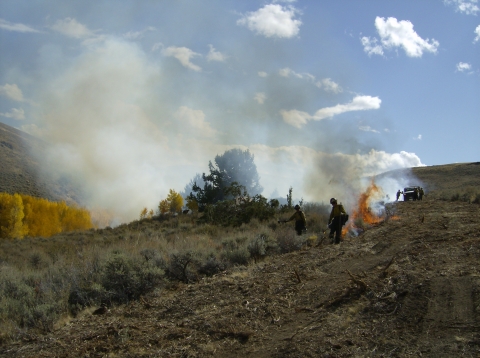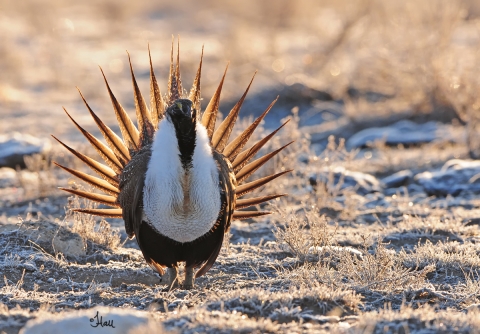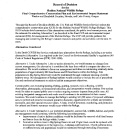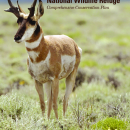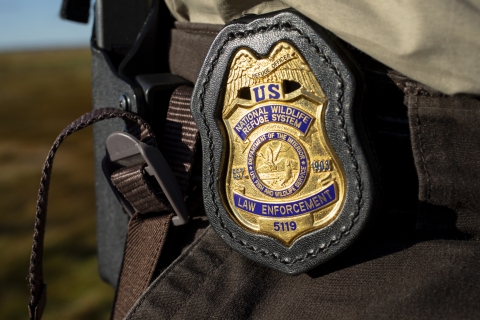What We Do
Refuges use a wide range of land management tools based on the best science available. Some refuges use prescribed fires to mimic natural fires that would have cleared old vegetation from the land helping native plants regenerate and local wildlife to thrive. Other refuges contain Wilderness areas where land is largely managed in passively. The management tools used are aimed at ensuring a balanced conservation approach where both wildlife and people will benefit. At this Refuge, the natural ecology maintains healthy populations of fish, wildlife, and plants, and little direct manipulation or management is needed on a regular basis.
The primary way in which habitats are currently managed to restore and maintain wildlife populations is through the manipulation and management of western juniper and fire. Prescribed fires and cutting back juniper allows space for important native sagebrush sagebrush
The western United States’ sagebrush country encompasses over 175 million acres of public and private lands. The sagebrush landscape provides many benefits to our rural economies and communities, and it serves as crucial habitat for a diversity of wildlife, including the iconic greater sage-grouse and over 350 other species.
Learn more about sagebrush ecosystems to thrive. Many species rely on sagebrush communities for survival. Some of these species include Greater sage grouse (found in no other type of ecosystem in the world), pygmy rabbits, sagebrush lizards, songbirds, and several iconic big game animals such as pronghorn, mule deer, and bighorn sheep.
Learn more about fire management here: Fire Management
Learn more about greater sage grouse here: Greater Sage Grouse
Hunting, fishing, and trapping: Hunting, fishing, and trapping are wildlife management tools used on some national wildlife refuges. These tools may be used to protect endangered and threatened species or migratory birds or to control certain wildlife populations. The U.S. Fish and Wildlife Service views hunting, fishing, and trapping as legitimate recreational and economic activities. Outside of Alaska, refuges that permit trapping as a recreational use may require trappers to obtain a refuge Special Use Permit. Hunting and fishing licenses must be purchased in accordance with the Nevada Department of Wildlife and all state and refuge rules and regulations apply. Contact the refuge manager for more information.
Management and Conservation
The National Wildlife Refuge System is a series of lands and waters owned and managed by the U.S. Fish and Wildlife Service. Wildlife conservation is at the heart of the refuge system. It drives everything we do from the purpose a refuge is established, to the recreational activities offered there, to the resource management tools we use. Selecting the right tools helps us ensure the survival of local plants and animals and helps fulfill the purpose of the refuge.
At this Refuge, some of the conservation tools we use include:
- National Wildlife Refuge System Improvement Act of 1997: The NWRS Improvement Act defines a unifying mission for all refuges, including a process for determining compatible uses on refuges, and requiring that each refuge be managed according to a CCP. The NWRS Improvement Act expressly states that wildlife conservation is the priority of System lands and that the Secretary shall ensure that the biological integrity, diversity, and environmental health of refuge lands are maintained. Each refuge must be managed to fulfill the specific purposes for which the refuge was established and the System mission. The first priority of each refuge is to conserve, manage, and if needed, restore fish and wildlife populations and habitats according to its purpose.
- Comprehensive Conservation Plans (CCPs): Refuge conservation plans are called “Comprehensive Conservation Plans” (CCPs). The purpose of the Sheldon Refuge CCP is to specify management direction for the Refuge for the next 15 years. The goals, objectives, and strategies for improving Refuge conditions—including the types of habitat we will provide, partnership opportunities, and management actions needed to achieve desired conditions – are described in the CCP. The Service’s preferred alternative for managing the Refuge and its effects on the human environment, are described in the CCP as well.
- The Nevada Wildlife Action Plan details the state of Nevada's priorities for addressing the state's conservation needs with respect to fish and wildlife. The action plan is developed as part of the State Wildlife Grants Program and is approved by the U.S. Fish and Wildlife Service and therefore is carefully considered when developing and revising Refuge Comprehensive Conservation Plans.
Strategic Habitat Conservation is an initiative by the U.S. Fish and Wildlife Service to consider and plan for resource conservation on an ecological basis at a large-landscape scale. This approach to conservation recognizes that in order to help wildlife and natural systems cope with complex and far-ranging threats such as drought, climate change climate change
Climate change includes both global warming driven by human-induced emissions of greenhouse gases and the resulting large-scale shifts in weather patterns. Though there have been previous periods of climatic change, since the mid-20th century humans have had an unprecedented impact on Earth's climate system and caused change on a global scale.
Learn more about climate change and large-scale habitat fragmentation, we must work strategically with partners to conserve landscapes capable of supporting self-sustaining populations of fish and wildlife, while also providing for the needs of people.
Law Enforcement
U.S. Fish and Wildlife Service law enforcement officers have a wide variety of duties and responsibilities. Officers help visitors understand and obey wildlife protection laws. They work closely with state and local government offices to enforce federal, state, and refuge hunting regulations that protect migratory birds and other game species from illegal take and preserve legitimate hunting opportunities.
Laws and Regulations
On National Wildlife Refuges wildlife comes first. Refuges are not managed for multiple uses like other public lands managed by the U.S. Forest Service and Bureau of Land Management. A variety of activities such as overnight camping, motorized travel, and horseback riding are allowed, but all recreation activities here are regulated to ensure wildlife is protected. Allowing recreation within the refuge depends upon your ability to know and follow refuge rules and regulations
A Special Use Permit is required for any commercial use and for any use or activity other than public hunting, fishing, wildlife observation, wildlife photography (except from March 1- June 1), environmental education, and interpretation which are the priority wildlife dependent uses compatible with the purposes for Sheldon National Refuge.
Please see the Visit Us page for a list of specific Sheldon National Wildlife Refuge rules and policies

